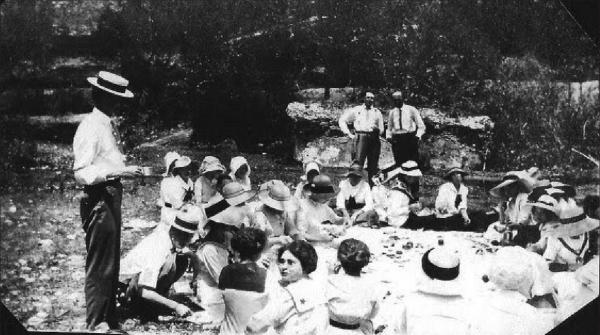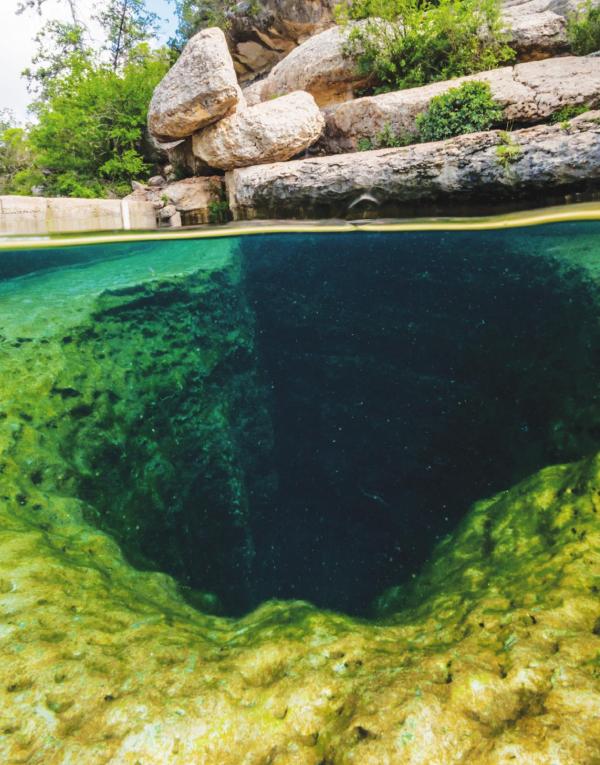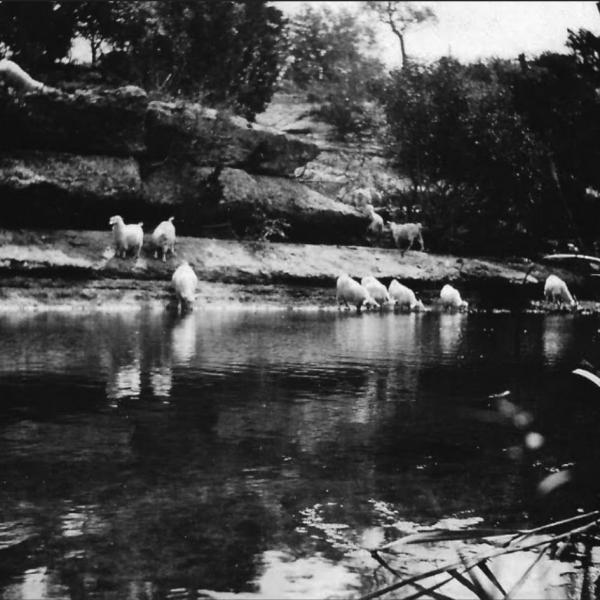DIVING INTO JACOB’S WELL
Wimberley’s history, beauty and lore are intertwined with the cold, deep waters that spring forth from the aquifer below and bless this region with Cypress Creek. This is the first of a four part series looking at the historical, cultural and environmental impacts created by diving into Jacob’s Well.
Peering from the rocks above, Jacob’s Well carries an aura of mysticism that deepens as quick as the vibrant colors of light fade to black in the mouth of the cavernous opening that serves as the headwaters of Cypress Creek.
For some, it is a popular destination spot for tourists across the globe as they experience a Wimberley Baptism head first from the rocks by plunging themselves into the chilly waters below.
For others – many hiding behind their keyboards – the mysticism is more supernatural, as they learn about the history of the lives of unwary scuba divers that have been claimed, as Louie Bond once said, “answering the siren call of the cave.”
But even with its cultural significance, it isn’t simply for swimming. The creek itself is the arterial vein of the Wimberley Valley as it ebbs and flows to the Blanco River sprouting the foundation for the local flora and fauna.
For landowners, it is the life force of the valley. The well is an above ground indicator of the supplies available in the Trinity Aquifer below, which offers the water for all of the residents in Wimberley.
As so many people continue to be either fascinated or even haunted by Jacob’s Well, very few people actually know the answers to the most important questions. What is Jacob’s Well? Why is it so important to the Wimberley Valley?
To answer these questions, time must be rewound back before explorer Jacob De Cordova surveyed what would become Wimberley and before Williams Winters began to tame the area.
As Katherine Sturdivant, who works at Jacob’s Well Natural Area as part of the Education and Outreach programs, explains, Jacob’s Well was a significant landmark in the area as many of the nomadic indigenous tribes used the well as a drinking source and shelter.
“They (Jacob De Cordova and William Winters), were not the first people to find the spring,” Sturdivant said. “The indengous tribes here, who were mostly nomadic, have been found throughout Central Texas for thousands of years. It’s highly likely that they were aware of this spring along with many others such as the San Marcos Springs and the Comal Springs. They would have had this site on their mental map, so to speak, because it’s a site of clean flowing water. It would have attracted wildlife, and these rock overhangs would have provided shelter for the traveling groups of people.”
Though the indication of the presence of Indigenous tribes has been theorized, evidence of their presence has been lacking due to flooding and the area being privatized since the 1800s.
“There is very little archaeological evidence to indicate this,” Sturdivant said. “We experience a lot of floods through here that washes things here very quickly, and since the 1800s a lot of this land has been private, which means it’s been heavily picked over. Artifacts that may have been laying on the surface are no longer there and have been claimed. So there are archaeological sites around here, but none have been found inside the park and no artifacts have been found inside the park. But we are fairly certain that those people were here. It’s just really hard to say with absolute certainty.”
Following the war for Texas Independence, tracts of land were being given to soldiers who fought for the Republic of Texas.
One of these soldiers was William C. Winters, the founder of what would be known as Wimberley, was given land further down Cypress Creek by Jacob De Cordova.
Winters then established what would become Winters Mill on the banks of the Cypress Creek while also building the first house in Wimberley, which still stands today.
As the tale goes, Winters also became the first white settler to discover Jacob’s Well as he traveled up Cypress Creek to discover the head waters.
It was here he came up with the iconic name of “Jacob’s Well,” but that has since been debated whether it was Winters or De Cordova who gave the well it’s current name.
“The legend has it that he (Winters) was walking up the creek and heard a roaring rush of water,” Sturdivant said. “He walked up on the well where it was pushing the water up like a geyser saying it was like biblical times and named it after a biblical reference. That is one of the stories. The other is that Jacob De Cordova named it after himself.”
Being a part of the 600-acre land tracts that De Cordova was selling to the settlers, Jacob’s Well became a corner tie for five different land parcels and soon became an area for livestock owners to raise their animals.
“Those were given to people who fought in the Texas Revolutionary War,” Sturdivant said. “Some of them moved out here… Most of this land remained private land until 2010. Through that time, this area was a ranch for at least sheep farming as well as other livestock.”
However, people soon began to discover that Jacob’s Well was more than just a drinking source for animals as guests began to flock towards the well.
“As soon as we moved into the 1900s, especially downstream from us, there were cabins where people from San Marcos would come out and stay,” Sturdivant said. “Moving into the 50s, 60s, and 70s the entire upper portion of the park was a RV park. Using aerial imagery, you can still see some of the RV pads.”
It was also during this time that Jacob Well’s would garner a dark reputation that some people consider to be unwarranted.
“People started accessing this cave system via scuba during the 50s and 60s after the advances made with scuba diving that were made to the general public,” Sturdivant said. “People have tried to enter the cave prior to that with little luck, but once they had scuba equipment it made it really easy to explore the cave. But what they quickly found out was that this cave goes over 100 feet, which now we know it goes over 137 feet deep and a mile of cave system underneath us. With no air pockets or light source, it must be done completely in the dark all via air tanks.”
With the cave being littered with false chambers, there are areas that look like exits but are dead ends and places where the width narrows to 15 inches. Jacob’s Well is considered to be one of the most dangerous underwater caves having claimed the lives of nine divers that have been confirmed dead, leading the natural area to ban scuba diving within the cave. Persistently, online videos recapping the details of those lost “diving into Jacob’s Well,” go viral with many being viewed millions of times across the world.
As of now, the only allowed diving within Jacob’s Well is by the Jacob’s Well Exploration Project.
But despite the dark reputation, it wasn’t the biggest challenge Jacob’s Well was going to face.
Due to the amount of growth in the Wimberley Valley and the increased need to pump groundwater, Jacob’s Well stopped flowing for the first time in 2000.
For many it was the wake up call the Wimberley Valley needed to hear.
“When it dried up completely for the first time in 2000, the water level was sitting even with the mouth of the spring,” Sturdivant said. “Not a single drop of water was moving downstream at that point and the water level was dropping and retreating into the passageway. Luckily it didn’t happen for very long so the water came back up but it was incredibly alarming.”
To avoid any more damage and to protect the well from urban development, Jacob’s Well was then purchased by Hays County in 2010 through the help of the Wimberley Valley Watershed Association led by David Baker who helped create the organization back in 1996.
Though it serves as a natural area for the Wimberley Valley under the protection of Hays County, there is still work to be done for Jacob’s Well as the area goes into the future.
“We have gone through a transformation in the public eye of being a local swimming hole, or a water source that is always guaranteed to be a resource that we now have to protect and converse for the future,” Sturdivant said. “It’s not something that is on everybody’s mind when they are on vacation, but part of my job is letting people understand that they should care.”




